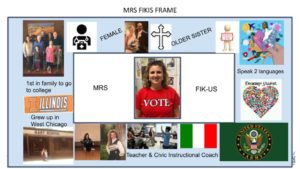August is the New January- Back to School Tools to Start the New Year

Fall is in the air! For educators, this is our “New Year,” full of resolutions and hopes for a new semester. One of my favorite quotes that captures the possibilities of the autumn is from the movie, You’ve Got Mail where Joe Fox, played by Tom Hanks, gushes to his pen pal Kathleen Kelly, played by Meg Ryan,
Don’t you love New York in the Fall? It makes me want to buy school supplies… I would send you a bouquet of newly sharpened pencils if I knew your name and address
While I would like to send each and everyone one of our #CivicsInTheMiddle friends a bouquet of freshly sharpened pencils, I will have to make do with sharing an “arrangement” of our favorite ideas and resources to support you as you embark on the 2021-22 school year.
Reflect on the Past to Inform the Present
Your students will come to you with various thoughts and feelings about returning to school. Take time to have them reflect on their experiences from the past year, have a voice in recalibrating classroom practices to create routines for success, and engage in a collective renewal of goals for the 2021-22 school year.
The following activities can be used to help students reflect on their experiences last school year and share their thoughts about the “new year.” Choose one to start with and use the others to check in throughout the year to recalibrate classroom practices.
- Have students individually complete the following sentence, “When I think about returning to school this fall, I feel_____________ because________________.”
- Use some of the Visible Thinking Routines from Project Zero:
- Compass Point Reflection has students identify something that is worrisome, exciting, a need to know, and a suggestion for moving forward.
- Color, Symbol, Image has students share and explain a color, a symbol and an image they think represents the return to school.
- 3-2-1 Bridge can be used to have students identify 3 ideas they have about being successful this school year, 2 questions they have, and 1 idea they have for improvement.
- Claim, Support, Question can be used to have students make a claim about returning to school, support it with evidence from their past and ask a question.
Collect the responses and display them in a chart or word cloud. Discuss the responses. Engage in a proactive conversation about what can be done to address past issues and co-create new routines.
Small changes in classroom interactions can make a big difference for traumatized students. Review these Trauma-Informed Teaching Strategies from ASCD.
Engaging Student Voice in Creating Classroom Culture and Norms
As we shared in a previous blog post, ALL educators are civic educators. The way we run our schools, our classrooms, the climate we create with our practices and policies all send messages to students about power, identity, equity, justice — key concepts that are core to civics. To ignore the role of democratic classroom practices that engage students in the management of their classrooms and schools denies them the opportunity to build their civic skills and attitudes. To this end, these undemocratic practices widen the civic empowerment gap and do a disservice to the civic mission of schools.
How can we create a civic and collaborative space for students to thrive during the school year in which clear norms and expectations are clearly defined to create mutual respect and responsibility for learning? Here are some tools.
- The Science Behind Classroom Norming from Edutopia explains why this is an important practice.
- Addressing Equity through Including Student and Family Voice in Classroom Learning by the Institute for Educational Science and Regional Educational Laboratory-Pacific
- Reframing Classroom Management: A Toolkit for Educators from Teaching Tolerance, “offers educators a variety of tools to help demystify common behaviors and reinforce what works”.
- Cult of Pedagogy has numerous resources around Classroom Management to inspire your back-to-school plans.
- Edutopia has a cornucopia of blogs, videos, tips, and tricks to establish classroom norms.
- In the Teaching Channel Blog, Building Democratic Classrooms: Every Teacher Can Cultivate Civic Competencies, educator Heather Van Bethuysen shares how to breathe civic life into all classrooms.
- Facing History and Ourselves Back to School Toolkit has ideas for the first few days of school.
Community Building Activities
We have all heard of the importance of putting “Maslow before Bloom,” or creating a brave and safe space for students to learn. Creating such a classroom takes time and intention. Here are some tools that can help.
- Facing History and Ourselves has an Identity Chart Activity that can help students consider the many factors that shape who we are as individuals and as communities. Sharing their own identity charts with peers can help students build relationships and break down stereotypes. In this way, identity charts can be used as an effective classroom community-building tool.
- Have students create their own “identity frame” to introduce themselves to the class, including how to pronounce their names. like Illinois Civics Instructional Coach, Candace Fikis modeled for her class below.

-
- We Are Teachers shared
- Educator Sara Wilcox shares her strategies to get to know her students in this Teacher to Teacher post, “In Our First Interactions With Students, We Need To Be the Learners”
- Cult of Pedagogy has:
- Lessons in Personhood: 10 Ways to Truly Lead Your Classroom
- Icebreakers that Rock
- a 4-Part System for Getting to Know Your Students
- Edutopia has
- Visible Thinking from Project Zero has a number of community-building activities to promote the understanding of others.
- Circle of Viewpoints: This routine helps students see and explore multiple perspectives. It helps them understand that different people can have different kinds of connections to the same thing and that these different connections influence what people see and think.
- Same and Different: This routine helps learners go beyond the surface of similarities and differences. Complex matters are often presented and accepted as is. It’s not until they are questioned and explored more thoroughly and deeply and from different angles that they can be better understood, leading to more thoughtful opinions and decisions.
- Who Am I? Explore, Connect, Identify, Belong: It is not unusual for people, systems, objects, or ideas to be judged or given labels without others really knowing much about them. This routine encourages students to reserve judgment, take time to find out more about what they see and/or hear, explore other people more deeply and broadly, as well as develop a greater understanding of similarities and differences.
Connecting with Parents
Parents and guardians have their own concerns about sending their children back to school. Clear lines of communication can be a valuable asset in navigating the uncertainties of the school year.
- Communicate to families, students, and resource staff when you will be checking your email and voicemail and the reasonable response time in which people can expect an answer from you.
- If you respond more quickly to email than voice mail, say so.
- Put this information in multiple locations. Your syllabus is not enough. Students and families are juggling multiple syllabi. Consider putting this information on the automatic/vacation reply on your email, articulating this on your voicemail message, and on your course webpage if you have one.
- You can put a hyperlink or QR code to this information on your first several assignments so students can readily access the information if needed.
- Create “office hours” where you are available by phone or via a virtual meeting platform for people to reach out to you in real time.
- Consider varying your time slots for students and families who may have unconventional schedules due to work and childcare concerns.
- Post this information in numerous locations.
- Consider creating a Week at a Glance calendar to provide a “big picture” of the week. Where applicable, you can embed links to videos, assignments, and other documents.
- Use a platform like Talking Points to communicate with families in their home language.
- Consider creating a survey for students and families to complete in which they can share how they can best be reached and any extenuating circumstances that might help you better serve the student.
Responding to Community Concerns about Teaching Social Studies
Many of the current media narratives around social-emotional and civic learning in school provide both opportunities and challenges for classrooms as we enter into the new school year on the eve of a midterm election season. What can districts do to combat misinformation and create a school climate to help students, staff and the community navigate the brewing “culture wars?”
- The Illinois Civics Hub recently hosted a webinar, Sorting Facts from Fiction: What Districts can Do to Combat Misinformation in the Current Culture Wars, to explore proactive measures administrators can take to create a supportive school climate for all stakeholders. Participants heard from leading experts in school climate, civics, news literacy, and social-emotional learning. A recording of the webinar is available on the Illinois Civics Hub Webinar Archive along with blogs that share resources.
- The National Action Civics Collaborative Back to School Summer Toolkit has resources that can be used to communicate with parents and administrators.
- The Center for Information and Research on Civic Learning and Engagement (CIRCLE) at Tufts University Recently published What the Research Says: History and Civics Education.
- The National Council for the Social Studies released A Response to the Attacks on Social Studies Education in State Legislatures and Local Boards of Education.
What are your favorite tools and tips to start out the school year? Use our contact form to share your ideas! Together, we can prepare ALL students for civic life!
